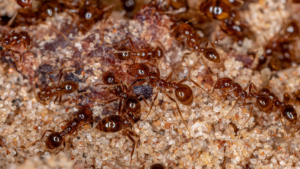
Fire ants are a common problem in West-Central Florida. They are not only a nuisance but also pose a danger due to their painful stings. Getting rid of these pests requires more than just a one-time treatment. To truly control fire ant populations, it’s crucial to understand their behavior and take consistent actions.
In this article, we will guide you through various strategies for long-term fire ant control. It covers understanding their behavior, using effective baiting methods, regular monitoring, and exploring both natural and chemical treatments. These steps will help you maintain a fire ant-free environment throughout the year. By following these strategies, you can protect your family and property from the discomfort and danger posed by fire ants.
Understanding Fire Ant Behavior and Nesting Patterns
Fire ants are social insects that live in colonies, which they build in the soil. These colonies can house hundreds of thousands of ants. Understanding their behavior is key to controlling them.
1. Nesting Habits: Fire ants prefer sunny, open areas to build their nests. Their mounds can be found in lawns, fields, and even along sidewalk edges. Each mound has a network of tunnels that extend underground, often going quite deep.
2. Seasonality: They are most active during the warmer months but can remain active year-round in milder climates like West-Central Florida. Rainfall often triggers the building of new mounds as fire ants move to higher ground.
3. Foraging Behavior: Fire ants are aggressive foragers and will travel far from the nest to find food. They form visible trails leading from the mound to food sources. These trails can help you identify where they’re most active and target those areas for treatment.
4. Colony Structure: A fire ant colony typically includes one or more queen ants, workers, and larvae. The queen’s primary function is to reproduce, laying thousands of eggs. This rapid reproduction rate makes it crucial to target the queen in any control strategy.
Effective Baiting Techniques for Fire Ant Control
Using bait is one of the most effective methods for controlling fire ants. It targets both the workers and the queen, offering a comprehensive approach to reducing the population.
1. Choosing the Right Bait: Fire ant baits often contain a combination of food attractants and insecticides. Choose a bait specifically labeled for fire ants. Granular baits are commonly used as they are easy to spread over large areas.
2. Proper Placement: Spread the bait evenly around the perimeter of the suspected mound and along foraging trails. Avoid placing bait directly on the mound as this can disturb the ants, causing them to relocate rather than feed on the bait.
3. Timing Matters: Apply baits when ants are actively foraging. This is usually in the late afternoon or early evening. Make sure the ground is dry as moisture can affect the bait’s effectiveness.
4. Amount to Use: Follow the instructions on the bait packaging for the correct amount to use. Using too much or too little can reduce the bait’s effectiveness.
5. Reapply as Needed: Fire ant colonies can sometimes relocate or new colonies can form, making it necessary to reapply the bait every few months during active seasons for best results.
Regular Monitoring and Maintenance Practices
Consistent monitoring and maintenance are essential for keeping fire ants under control. These practices help identify new mounds early and ensure long-term success.
1. Frequent Inspections: Regularly inspect your yard and property for new fire ant mounds. Walk around your lawn, garden, and any other open areas, especially after rainfalls which often trigger mound building. 
2. Record Keeping: Keep a log of where and when you find mounds. This helps in identifying patterns and areas that are more prone to infestations. Tracking treatments will also help in ensuring that they are effective.
3. Maintenance Tips:
– Mound Treatment: When you find a new mound, treat it immediately using bait or appropriate insecticides.
– Reapply Treatments: Even if no new activity is apparent, reapply bait and other treatments as recommended on their labels. This preemptive approach is essential in keeping the ants from re-establishing.
– Lawn Care: Maintain your lawn by mowing regularly and eliminating standing water. A well-kept lawn is less inviting to fire ants.
– Dispose of Debris: Remove any piles of leaves, wood, and other debris that can provide shelter for colonies.
Natural and Chemical Treatment Options
Both natural and chemical treatments offer effective solutions for fire ant control. Choosing the right one depends on your specific needs and preferences.
1. Natural Treatments:
– Diatomaceous Earth: This natural powder damages the exoskeletons of ants, causing them to dehydrate and die. Sprinkle it around mounds and entry points.
– Boiling Water: Pouring boiling water directly into the mound can kill a significant portion of the colony. Be careful when handling hot water.
– Essential Oils: Oils like orange and peppermint can deter fire ants. Mix a few drops with water and spray around infested areas.
2. Chemical Treatments:
– Insecticidal Baits: These contain slow-acting poisons that workers carry back to the colony. The poison then spreads, eventually killing the queen.
– Granular Insecticides: Spread these across your lawn to create a protective barrier. They often work for several months per treatment.
– Liquid Pesticides: Apply these directly to significant mounds for immediate results. Be sure to follow safety instructions carefully.
Conclusion
Maintaining long-term control over fire ants requires understanding their behavior, using effective baiting techniques, regularly monitoring them, and selecting the appropriate treatments. Fire ants can be persistent pests, but you can keep your property safer and comfortable year-round with a consistent strategy.
For expert help in tackling fire ant infestations, contact Plant It Earth. Our team offers specialized fire ant control services to keep your lawn and home free from these annoying pests. Take action now and enjoy a fire ant-free environment with our professional pest control solutions.
